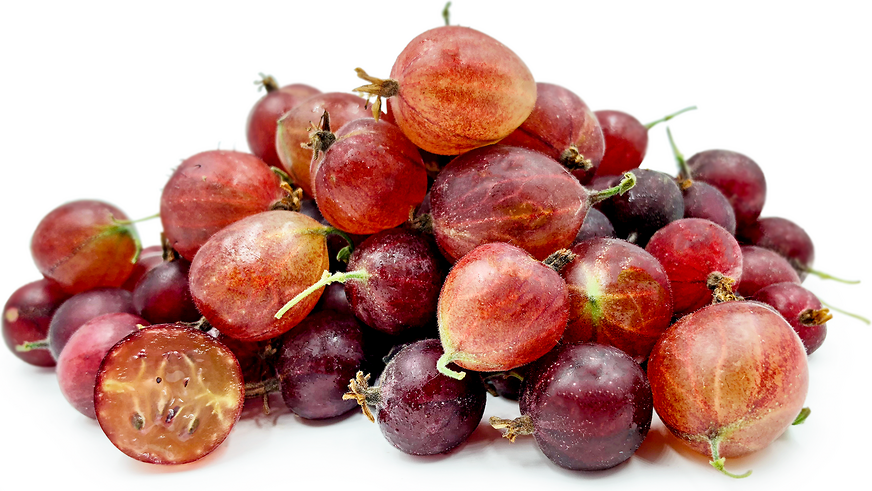


Captivator Gooseberries
Estimated Inventory, ea : 0
Description/Taste
Captivator gooseberries are small round fruits that grow in both clusters and as individual berries on large bush-like plants. They resemble red grapes by featuring a round to oval teardrop shape and measuring around 2.5 centimeters in diameter. The semi-translucent skin transitions from green to a red-pink or burgundy hue as they mature and they are often variegated with yellow splotches and veins that shine through. The flesh has a jelly-like consistency with a translucent yellow-red tint and contains small seeds. Captivator gooseberries have a sweet flavor with lingering tart notes.
Seasons/Availability
Captivator gooseberries are avaliable in the mid-summer months.
Current Facts
Captivator gooseberries are a hybrid variety botanically classified as Ribes uva-crispa 'Captivator' and belong to the Grossulariaceae family that includes all varieties of gooseberries and currants. Gooseberries may be categorized into American or European varieties. American varieties tend to be smaller and less flavorful than their European counterparts but they exhibit superior disease resistance. Captivators are a hybrid cross between the North American Ribes hirtellum and the European Ribes uva-crispa. They are bred specifically for cold hardiness, disease resistance, and large flavorful fruit production. Captivator gooseberries grow on plants that reach about 0.5 to 1.5 meters in height and can be cultivated as ornamental plants due to their green floral blooms in the spring. This nearly thornless variety is also recognized for its sweet fruits that are often used in preserves and baked goods.
Nutritional Value
Captivator gooseberries are a significant source of vitamin C, which supports immune function, skin health, eye health, iron absorption, blood vessel function, and protection against infections. They also provide vitamins B5 and B6, which promote energy metabolism, brain function, hormone production, wound healing, mood regulation, and heart health. The copper and manganese found in these berries aid in the formation of connective tissue, bone health, collagen synthesis, blood sugar regulation, and protection against free radical damage. Captivator gooseberries are rich in dietary fiber that promotes digestive health, helps maintain balanced blood sugar levels, contributes to feelings of fullness, reduces inflammation, and aids in lowering cholesterol levels.
Applications
Captivator gooseberries can be enjoyed in both raw and cooked applications. They are delicious fresh, in salads, fruit bowls, yogurt parfaits, and acai bowls. These gooseberries are often incorporated into baked goods such as fruit tarts, pastries, pies, clafoutis, cobblers, cheesecakes, pavlovas, and focaccia breads. They can also serve as a garnish for cakes, crème brûlée, and ice cream. Captivator gooseberries may be cooked down with sugar to create jams, jellies, and fruit sauces. They can be transformed into a tangy ketchup for pulled pork buns, blended with yogurt for a raita that complements Indian dishes, or cooked with tarragon to make a flavorful topping for pork chops. These fruits pair well with ingredients like elderflower, honey, saffron, white chocolate, coconut, clotted cream, ginger, smoked fish, paneer cheese, pickled cucumber, fennel, lemon, kale, and mixed greens. Captivator gooseberries should be consumed within a few days of harvest. To extend their shelf life store them in the refrigerator for up to a week.
Ethnic/Cultural Info
Gooseberries were once so popular in the United Kingdom that there were gooseberry clubs created with contests to grow the heaviest fruits. These clubs were especially popular in Northern England where there was even a publication created called The Gooseberry Growers Register. There were 171 gooseberry competitions being put on in 1845. The current world record for the heaviest gooseberry was set in 2013 at 64.49 grams, about the size of a large hen’s egg. This was the first gooseberry to exceed 40 pennyweights, a unit of measurement traditionally used for gooseberries alongside grains.
Geography/History
Captivator gooseberries were first developed in Ottawa, Canada, in the mid-1930s by the Central Experiment Farm and introduced to the public in 1949. Captivator gooseberry plants thrive in full sun exposure but are not tolerant of extreme heat. They grow best in areas with mild summers. The gooseberry industry in Europe faced a significant decline in the early 20th century due to the introduction of American gooseberry mildew fungus, which devastated many European varieties lacking resistance until crossbreeding with American types occurred. This led to the creation of cultivars like Captivator gooseberries, which gained popularity for their combined qualities from both American and European types, enhancing the potential for commercially successful gooseberry production. Today, Captivator gooseberries are commonly grown from seeds in gardens and can also be found at farmers' markets.
Recipe Ideas
Recipes that include Captivator Gooseberries. One
| The British Larder |
|
Gooseberry and Bay Leaf Jam |




